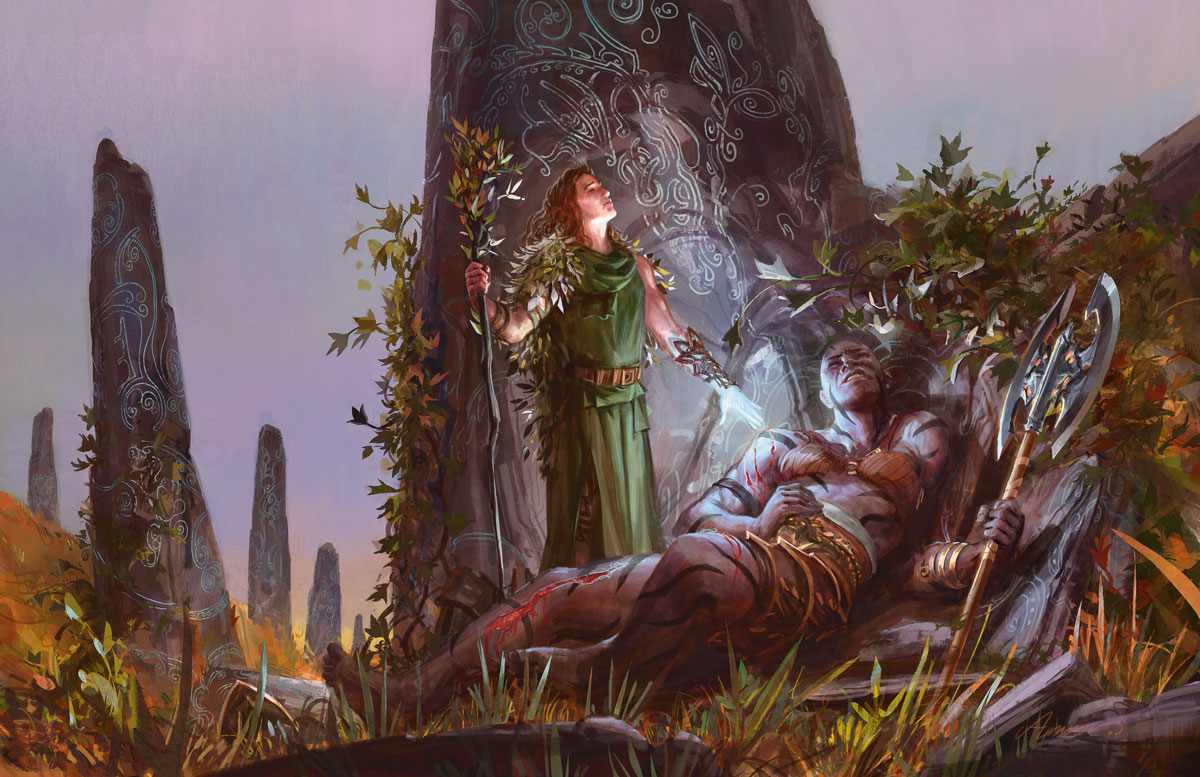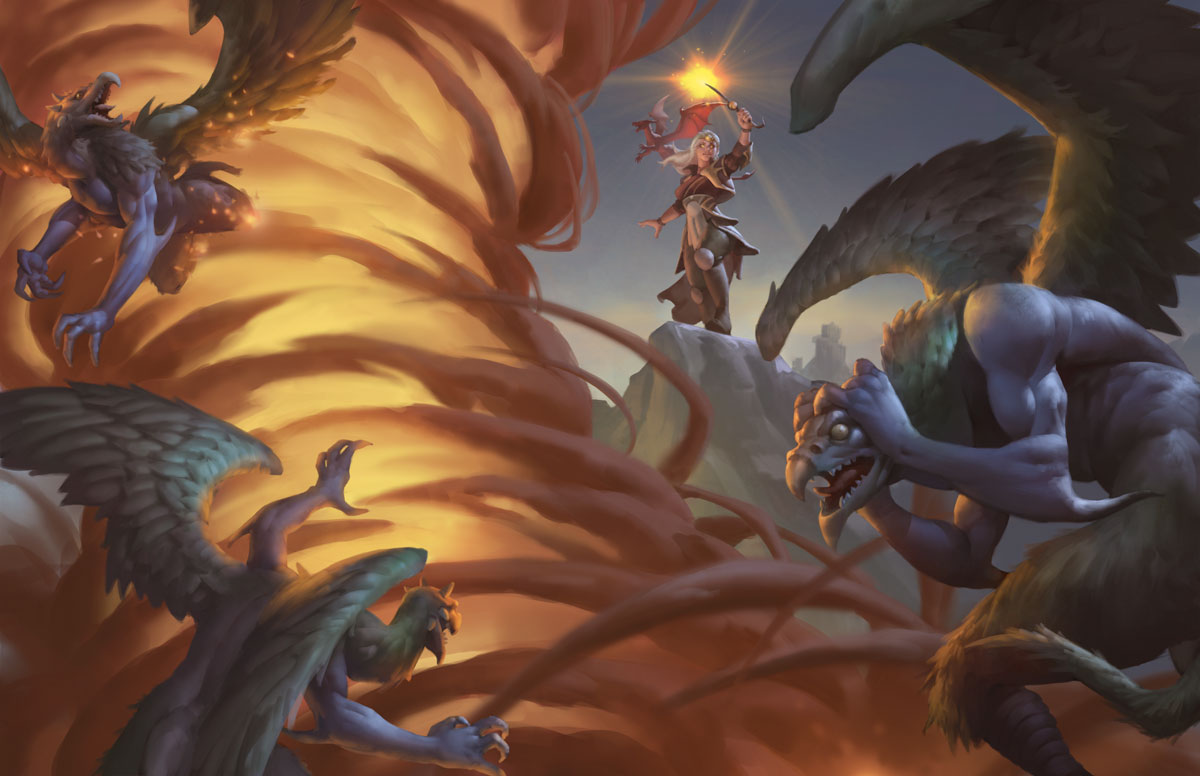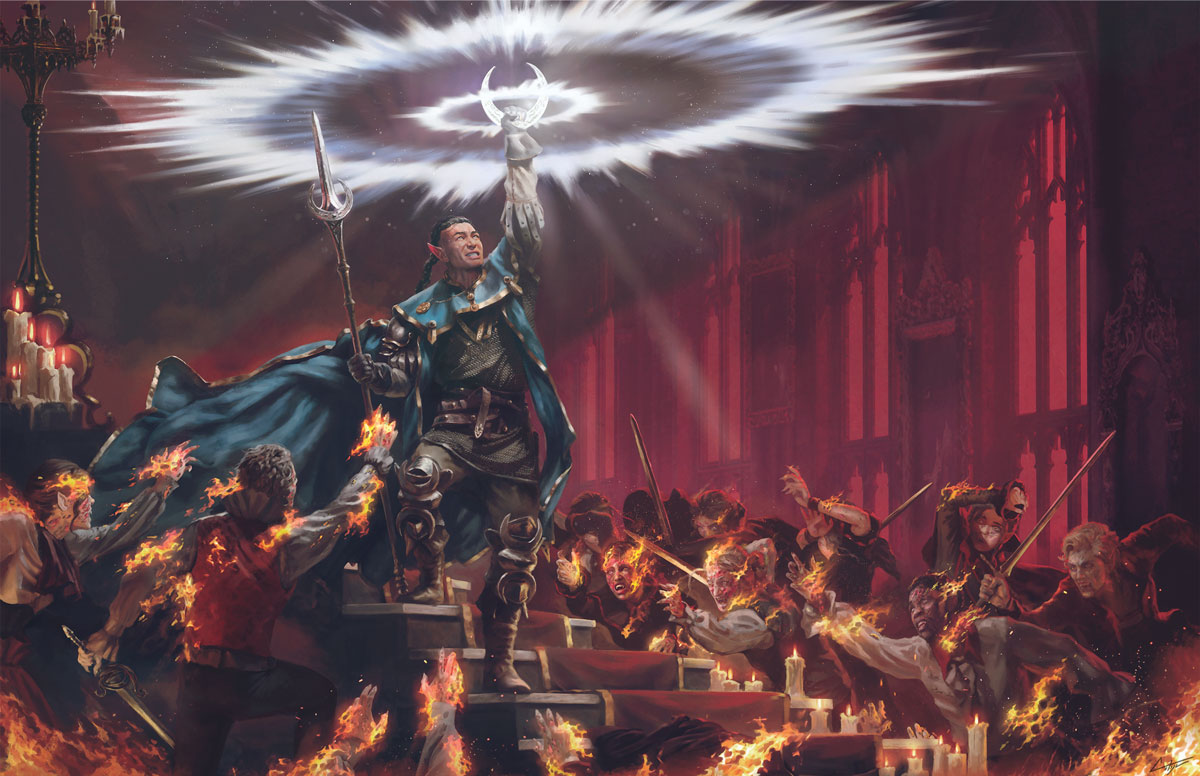Magic is one of the main elements that make Dungeons & Dragons so cool. Whether you’re pulling the Weave, strumming along to the Words of Creation, or drawing forth the divine power of your chosen deity (or patron!), using spells can give you the ultimate power fantasy: The ability to literally reshape the world around you. That’s why the 2024 Player’s Handbook is bringing you over a hundred pages of spells. You’ll find boosts to classic favorites, popular spells from sourcebooks being ported to the core rules, and even some brand-new spells!
In this article, we’ll discuss some of the overarching changes you’ll see with spells and even show you some of the new spells introduced in the 2024 Player’s Handbook.
- Many Favorite Spells Have Been Boosted
- It’s Easier to Find and Use Your Favorite Spells
- New Spells for the Core Rules
- Emanation Area of Effect
The 2024 Player’s Handbook is Now Available!
Buy the 2024 Player’s Handbook today and dive into revised rules, enhanced character options, and exciting gameplay innovations.
Get your copy on the D&D Beyond marketplace and seamlessly integrate your new content with D&D Beyond's library of digital tools built to make D&D easier, so you can focus on the fun!
Many Favorite Spells Have Been Boosted

One of the first things that long-term D&D players will notice when perusing the almost four hundred spells in the 2024 Player’s Handbook is that many of your favorite spells have been buffed up.
Your healing spells will keep you and your allies on your feet longer to reflect the cost of your action or Bonus Action and your spell slot in order to use them. For example, Cure Wounds now heals a base of 2d8 + your spellcasting modifier, and Healing Word similarly has a base of 2d4 + your modifier as a level 1 spell. And it’s not just dice increases. Many spells receive a new element of functionality. Prayer of Healing, which takes 10 minutes to cast, now grants the benefits of a Short Rest to up to five creatures in addition to restoring 2d8 Hit Points.
Damage-dealing spells have seen several boosts too. Cloud of Daggers used to have some diminishing returns on later rounds if enemies started to avoid your cube of swirling stabs. But that’s a thing of the past, because now you can use a Magic action on your later turns to move the cloud up to 30 feet. Similarly, Chromatic Orb has been updated with the potential to strike an additional enemy, really embracing the dodgeball vibe or chucking a magically infused sphere at your enemies.
A number of spells that saw little use from the 2014 Player’s Handbook version also saw some tweaks to make them more functional and enticing for you to add to your repertoire. Blade Ward, for example, was a fairly underused cantrip because it cost an action, only lasted a turn, and only granted resistance to Bludgeoning, Piercing, and Slashing damage for that one turn. Now, while it still takes a Magic action, this cantrip lasts for a full minute, with Concentration, and forces all enemies attacking you to subtract 1d4 from their attack roll for the duration.
These are just a few of the changes to some known spells, so be sure to look for your favorite spells in the 2024 Player’s Handbook to see what changes may be in store for you!
It’s Easier to Find and Use Your Favorite Spells

Speaking of looking up your favorite spells, the 2024 Player’s Handbook makes the process of finding, preparing, and using your spells as a player easier.
Now, you no longer need to flip to the back of the book to see what spells are available for your class. Each class has its designated spells listed in the class description for the class itself in the Character Classes chapter. So if you’re building a Cleric, the list of Cleric spells is right there in the same section as your class features and domain subclasses.
One of the big missions in revisiting spells was to really listen to and address questions and confusions players have had around various spells in the decade since the 2014 Player’s Handbook was first published. We tightened up the wording in some spell descriptions to make them clearer and more succinct, without changing the actual mechanics of the spells. We provided more artwork of the spells in use to give you more inspiration for imagining how the spell looks when you cast it. The Ritual tag has now been moved to the casting time to make it easier to find since it impacts the casting time of a spell.
As an example of changes to spells, the conjuring family of spells, such as Conjure Fey and Conjure Celestial, have been updated to officially reflect popular modifications that were playtested in Unearthed Arcana. The new versions of the spells now give you all the information you need when casting them in the spell descriptions themselves; for example, Conjure Fey specifies that the conjured spirit can make a melee spell attack against a creature within 5 feet, and on a hit, the target takes Psychic damage and has the Frightened condition.
This saves you from cracking open the Monster Manual to track your conjured creature’s information and makes them operate more similar to the Spirit Guardians or Spiritual Weapon spells.
New Spells for the Core Rules

The 2024 Player’s Handbook introduces some brand-new spells to the D&D spellbook. Some, like the Starry Wisp cantrip, were included in the Unearthed Arcana playtests, but some weren’t and will be making their debuts in the 2024 spell list.
Some of the brand-new spells include ties to the known spellcasters within the D&D multiverse. Our old pal Tasha has a brand new spell, Tasha’s Bubbling Cauldron, which creates a magical cauldron for 10 minutes that you and your allies can reach into and grab vials of a Common or an Uncommon potion of your choice. Jallarzi, a Celestial Patron Warlock with the distinction of being a non-Wizard member of the Circle of Eight, has a powerful namesake spell, Jallarzi’s Storm of Radiance. This spell creates a raging 40-foot cylinder storm that deals Radiant and Thunder damage. It also gives creatures within it the Blinded and Deafened condition and makes them unable to cast spells with a Verbal component.
Popular spells from the expanded sourcebooks have also now become part of the core spell list. Some, like Toll the Dead, introduced in Xanathar’s Guide to Everything, have gotten so ubiquitous that many don’t realize they weren’t initially part of the 2014 Player’s Handbook.
Emanation Area of Effect

Emanation is a new area of effect, joining known types like Cone, Line, or Sphere. An Emanation spell extends in a straight line in all directions from a creature or object, and moves with them if the spell duration is longer than Instantaneous. Emanation differs from a Sphere in that its origin is not considered part of the area of effect unless the Emanation’s creator decides otherwise (whereas a Sphere’s origin is always included in the area of effect). Known spells such as Thunderclap and Spirit Guardians are now classified as Emanation for their areas of effect.
This Spells Fun
The 2024 Player’s Handbook is now available on the D&D Beyond marketplace, which means it's time to set out on new adventures with fresh or familiar characters!
With almost four hundred spells spread across over a hundred pages, we’ve clearly only scratched the surface of the exciting changes coming to your spellcasting with the 2024 Player’s Handbook. Be sure to look through the complete spell list for your preferred spellcaster to see what changes are in store for your favorite spells, and what new spells are ready for you to play with.
We’re delighted to share with you the changes to fifth edition D&D that appear in the 2024 Player’s Handbook. Make sure to keep an eye out on D&D Beyond for more useful guides on using the wealth of new options, rules, and mechanics found in the 2024 Player's Handbook!

Riley Silverman (@rileyjsilverman) is a contributing writer to D&D Beyond, Nerdist, and SYFY Wire. She DMs the Theros-set Dice Ex Machina for the Saving Throw Show, and has been a player on the Wizards of the Coast-sponsored The Broken Pact. Riley also played as Braga in the official tabletop adaptation of the Rat Queens comic for HyperRPG, and currently plays as The Doctor on the Doctor Who RPG podcast The Game of Rassilon. She currently lives in Los Angeles.
This article was updated on August 13, 2024, to issue corrections or expand coverage for the following features:
- It’s Easier to Find and Use Your Favorite Spells: Added Conjure Fey as an example of how the new spell listing works.
- New Spells for the Core Rules: Remove plurality in the Tasha’s Bubbling Cauldron sentence to avoid confusion.
- Emanation Area of Effect: Clarified that the Emanantion’s creator can choose to include the origin in the area of effect.








-
View User Profile
-
Send Message
Posted Jul 4, 2024Yes and it is no longer Blade Ward. It's more like Attack Ward. I think it's a little too much. I always liked the idea of Blade Ward as being a reaction spell. In fact, that's a home rule of mine for Abjuration Wizards. What they've done makes it a different spell. And I don't like the concentration, though I agree it's necessary given the rather potent nature of the re-defined spell.
-
View User Profile
-
Send Message
Posted Jul 4, 2024You can do what I will probably do. Keep the old spell and make it a reaction instead of an Action, at least for Abjuration Wizards. What they did with Blade Ward is indicative of many of the changes. Made massive, overpowering upgrades to things that just needed minor tweaks.
-
View User Profile
-
Send Message
Posted Jul 4, 2024The fact that you think Blade Ward is massively overpowered is ridiculous to me. It has always been objectively one of the worst spells in the game. Personally, I think blade ward reminds me of Monty Hall, I'm sure you'll agree.
-
View User Profile
-
Send Message
Posted Jul 4, 2024While I like the idea, there were a few problems with trying to stuff 8 classes into 3 boxes. Having a single Arcane list for Sorcerers and Wizards works fine, as it does for Clerics and Paladins. But things get tricky beyond that. Rangers, IMO, are a weapon using class primarily, and their spells should support their out of combat abilities or enhance their weapon abiliities, not deal damage as the Druid can. Warlocks, with a few exceptions, use their spells mostly for support and use Eldritch Blast for reliable damage. They don't need access to the full Arcane list. Bards can do a little of everything, and need their own separate spell list, as will Artificer when it eventually gets made.
-
View User Profile
-
Send Message
Posted Jul 4, 2024As I understand, the spell is sixth level and the potions created that way have an expiration date of one day. So it's useful to cast the day before a big day, but not for breaking the world.
-
View User Profile
-
Send Message
Posted Jul 4, 2024I don't think Blade Ward is massively overpowered. Sorry for the poor word choice. I think the fix is way overboard, so, yes, Monty Hall.
-
View User Profile
-
Send Message
Posted Jul 4, 2024You can take the dodge action and everyone attacking you has disadvantage and you can still concentrate on spells.
-
View User Profile
-
Send Message
Posted Jul 5, 2024this right here is what ive been asking all week what happened to the daily updates?
-
View User Profile
-
Send Message
Posted Jul 5, 2024I believe they said or hinted that the artificer was not gonna be added to the core rulebook but that could totally be misinformation that i am spreading
-
View User Profile
-
Send Message
Posted Jul 5, 2024While your fixing the spells can you go back and fix the 2024 Paladin and Ranger please?
-
View User Profile
-
Send Message
Posted Jul 5, 2024Here's a hint, if you are adding concentration to a spell, ESPECIALLY a combat spell, you are making it less likely to be used. All the big spells possible to be concentrating on and you turned Blade Ward into a weaker, more selfish version of Bane. Yea... that's more likely to get used than the old blade ward. It will be looked at, maybe trick a new player into thinking it is cool, and get cast once breaking their concentration on a bigger, better spell and then never used again.
-
View User Profile
-
Send Message
Posted Jul 5, 2024Like how they neutered Counterspell.
-
View User Profile
-
Send Message
Posted Jul 5, 2024The bigger problem with 2024 Blade Ward is that it's now useless for actual casters, who have better things to do with their concentration, and borderline OP on a fighter who takes Magic Initiate as their level 1 feat. They already have con save proficiency, nothing else to concentrate on, and high AC to make the most of any reduction in enemy attack rolls. I don't know what the design intent was of this change, but that's going to be the actual consequence.
-
View User Profile
-
Send Message
Posted Jul 5, 2024Is simulacrum still broken? Is maze still broken? Is Shield still broken? Are wall of force and force cage still broken? Are fear and hypnotic pattern still broken? Is sleep still broken? Is web still broken? Is Evard's Black Tentacles still broken? Is animate objects still broken? From what I saw on the video I have 0 expectations wish was fixed so I am not going to ask about that one.
-
View User Profile
-
Send Message
Posted Jul 5, 2024someone might have told you, but i know of some changes, counterspell is a con save now, and if you fail it you keep the spell slot. Also i think every "conjure _____" spell has been changed to a placeble spirit guardians.
-
View User Profile
-
Send Message
Posted Jul 6, 2024How is Shield broken? In fact, how are most of these broken?
-
View User Profile
-
Send Message
Posted Jul 6, 2024Sad about guidance being only 1 specific skill, but it had to be done for the sake of the balance. For the best, probably
-
View User Profile
-
Send Message
Posted Jul 6, 2024Shield lasts an entire round and breaks bounded accuracy, it allows casters to have higher AC than martial without multiclassing. Simulacrum breaks campaigns by basically doubling a PC with the possibility of doubling multiple PCs. Maze takes out any enemy out of combat without a save. Same for wall of force and force cage. Hypnotic pattern and Fear affect multiple enemies and do not allow repeated saves at the end of the turn. Sleep inflicts the most debilitating condition on a group of enemies at level one, but is only considered broken at level 1 when enemies have low hp. Web does not allow for repeated saving throws and asks for an action ability check to escape. Web is the same as Evard's Black Tentacles. Animate objects tiny object slows down gameplay similarly to conjure spells and does an absurd amount of damage compared to the other options.
-
View User Profile
-
Send Message
Posted Jul 7, 2024#Agreed
Maybe it does more damage if you use a higher spell slot now!
I'm still holding out hope that they retooled several of the concentration spells on the Ranger's list. As it is there are over 30 concentration spells.
-
View User Profile
-
Send Message
Posted Jul 7, 2024According to my Google search, this spell was in the Unearthed Arcana as level 6. Seems like a pretty bad spell for a 6th level slot.